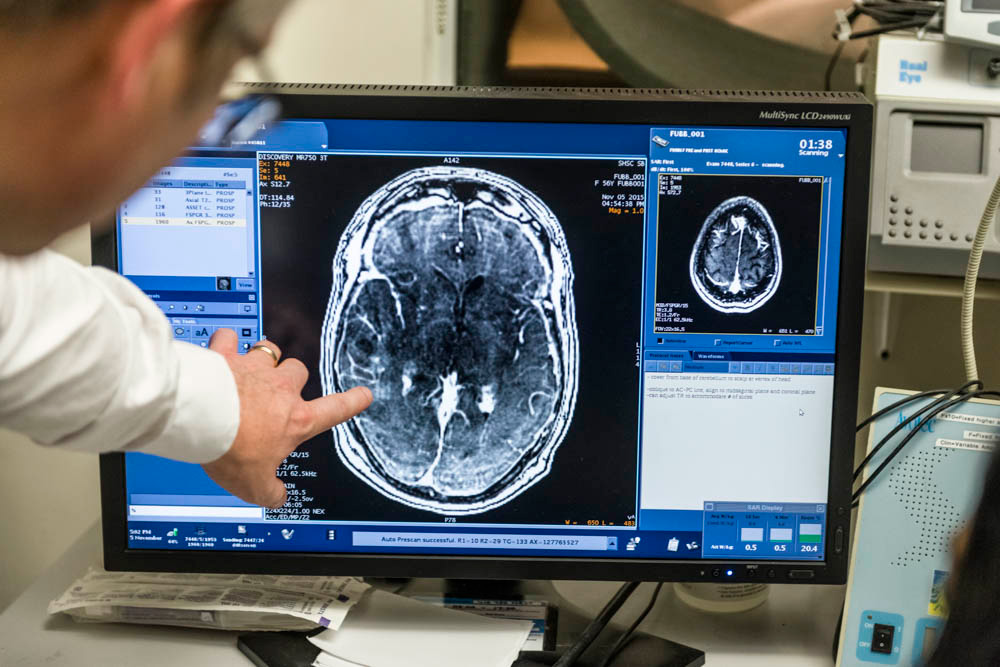World first: blood-brain barrier opened non-invasively to deliver chemotherapy
Sunnybrook scientists made history this week as they used focused ultrasound to non-invasively breach the blood-brain barrier and more effectively deliver chemotherapy into the brain tumour of a patient.
Each person has a protective barrier that normally restricts the passage of substances from the bloodstream into the brain protecting it from toxic chemicals.
“The blood-brain barrier (BBB) has been a persistent obstacle to delivering valuable therapies to treat disease such as tumours,” says Dr. Todd Mainprize, principal investigator of the study and Neurosurgeon in the Hurvitz Brain Sciences Program at Sunnybrook Health Sciences Centre.
“We are encouraged that we were able to temporarily open this barrier in a patient to deliver chemotherapy directly to the brain tumour.”
The research team infused a chemotherapy drug, then tiny, microscopic bubbles, into the bloodstream of a patient with a malignant brain tumour. The microbubbles are smaller than red blood cells and pass harmlessly through the circulation. The researchers then used state-of-the-art MRI-guided focused low-intensity ultrasound (sound waves) to target blood vessels in the BBB area near the tumour. The waves repeatedly compress and expand the microbubbles, causing them to vibrate and loosen tight junctions of the cells comprising the BBB. Once the barrier was opened, the chemotherapy flowed through and deposited into the targeted regions.
“Some of the most exciting and novel therapeutics for the treatment of malignant brain tumours are not able to reach the tumour cells because of the blood brain barrier. This technique will open up new opportunities to deliver potentially much more effective treatments to the targeted areas,” says Dr. Todd Mainprize, also an Assistant Professor in the Division of Neurosurgery at University of Toronto.
Dr. Kullervo Hynynen, Director of Physical Sciences at Sunnybrook Research Institute, worked with industry partner Insightec for almost two decades to develop the technology and bring it to a clinic-ready state. “The success of this case is gratifying,” he says. “My hope now is that many patients will eventually benefit from it.”
Less than 24 hours after breaching the blood brain barrier, the tumour and some surrounding tissues were surgically removed and sent to pathology to measure differences in the concentration of chemotherapy that deposited in the area treated by the focused ultrasound and the area not treated.
“Breaching this barrier opens up a new frontier in treating brain disorders,” says Dr. Neal Kassell, chairman of the Focused Ultrasound Foundation. “We are encouraged by the momentum building for the use of focused ultrasound to non-invasively deliver therapies for a number of brain disorders.”
The success of this research opens up the potential for delivering drug therapies to parts of the brain protected by the blood brain barrier, including researching treatments for patients with various kinds of brain tumours, Alzheimer’s disease, and some psychiatric conditions.
“This is a very important step in the development of MR-guided focused ultrasound technology,” says Eyal Zadicario, VP R&D and Director of Neuro Programs at Insightec. “We continue to push the technology into new clinical applications that can have significant impact where it matters most — to patients.”
This case was the first of up to 10 participants in this study, which is testing for feasibility, safety and preliminary efficacy. The participants are those already scheduled for traditional neurosurgery to remove parts of their brain tumour.
This study is funded by the Focused Ultrasound Foundation. The research equipment is funded by the Canada Foundation for Innovation and Ontario Ministry of Research and Innovation, with support from the Bombardier Foundation. The research has also received significant support from the Canadian Institutes of Health Research and National Institutes of Health. Dr. Hynynen holds the Canada Research Chair in Imaging Systems and Image-Guided Therapeutics. The focused ultrasound apparatus and technology are Insightec’s Exablate Neuro System.







